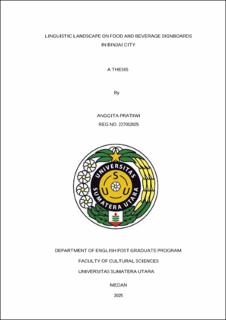| dc.description.abstract | The study of Linguistic Landscape (LL) examines how people, whether
monolingual, bilingual, or multilingual, utilize language in public settings. The food
& beverage scene in Binjai City, North Sumatra, is renowned for its diverse and
vibrant flavors that reflect the city's rich cultural heritage. This research provides
valuable insights into the evolving linguistic landscape of a rapidly growing city
influenced by globalization and local traditions. The purpose of this study was to
find the language characteristics of the linguistic landscape of food & beverage
sigboards in Binjai City ; to investigate the realization of linguistic items of food &
bevarage signboards in Binjai City, and to understand the importance of language
choice in the linguistic landscape of food & bevarage signboards in Binjai City.
This research method is qualitative by applying the data collection of food and
beverage signboard. The model applied in data analysis is interactive which
observed the picture then captured the pictures on languages displayed function,
classified and described the realitation, and explain the reasons why English is used
in the linguistic landscape on food and beverage signboards in Binjai City. The
result showed that the researcher found 45 total signboard with 2 language
characteristics: Monolingual and Bilingual. It was found that English is more
dominant than Indonesian language. The overwhelming majority of food and
beverage establishments in Binjai City use monolingual signboards in Indonesian,
accounting for 68,89% of the total. A smaller portion of businesses, 31,11 %, utilize
bilingual signboards, specifically combining Indonesian and English. The study
found that the realization of the linguistic landscape is shaped by both local identity
and the influence of global trends. The reason of the owner use of English on
signboards is not merely decorative; it serves to signal modernity and
sophistication, drawing in customers who associate English with global appeal and
higher quality. | en_US |


